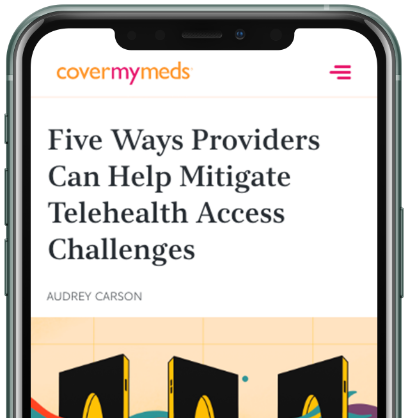4 Benefits of Electronic Prior Authorization over Phone and Fax
Why use electronic prior authorization (ePA) instead of fax machines and phone calls? Here are four reasons to skip manual processes and use ePA to submit your next prior auth request.

Paperwork or patients? It’s a delicate balance that healthcare teams face every day – and managing prior authorization requests for prescription medications is a major source of that paperwork.
While our research shows 96% of healthcare providers have adopted a solution for electronic prior authorization (ePA),CoverMyMeds, 2021 Medication Access Report some care team members still choose manual methods to submit prior auth requests.
By helping to automate the prior auth process, ePA solutions make it faster and easier to review, complete and track requests. So why do some caregivers still choose to juggle phone calls, faxes, multiple logins and a mix of access points?
If you or your colleagues still need convincing, here are four reasons to hang up the phone and say hello to ePA. (Questions about our website? Read our “Quick Guide to CoverMyMeds Prior Authorization Requests.”)
BENEFIT 1: ITS EASIER TO SUBMIT PROACTIVE PRIOR AUTHS WITH ePA
Rather than waiting for a claim rejection before submitting a prior auth, proactively submitting prior auths electronically at the time of prescribing can help patients access medications faster.CoverMyMeds data on file, 2018
Many provider offices only complete a prior auth request retrospectively, once a pharmacist requests it after a claim has been rejected. (Explore 7 common prior auth hurdles and how to overcome them.) So, the decision to use phone, fax or ePA is often reactive.
If a provider’s office receives a prior auth request via phone or fax, they’re likely to respond via that method. Likewise, if the provider gets a notification to complete an ePA for a patient, they’re more likely to use ePA.
If the healthcare provider submits proactive prior auth requests at the time of prescribing, without waiting on the pharmacy, that reactive process becomes proactive and more efficient. Our research shows patients access their medications up to 13 days sooner, on average, when prior auth requests are started proactively at the provider’s office.CoverMyMeds data on file, 2018
82% of physicians surveyed by the American Medical Association in 2023 said the number of prior auths had increased since 2018. The same survey found that practices complete an average of 43 prior auths per physician each week.2023 AMA prior authorization physician survey
BENEFIT 2: ePA IS FASTER THAN PHONE AND FAX
If there’s a sense of urgency, a provider may perceive the phone as “faster” than ePA. However, our 2022 survey found that ePA submissions are faster than both picking up the phone or faxing a paper form.CoverMyMeds user survey comparing time to prior auth completion between ePA, phone and fax, 2022
Some care team members may feel that calling in prior auth requests allows them to "tell the whole story" – even though the questions that they answer over the phone are the same questions on the electronic form, including working with Medicare and Medicaid.
While they can have a verbal conversation, they may wait on hold for a significant period of time before they speak to someone. In today’s busy provider offices, that hold time can be better spent on other tasks.
BENEFIT 3: WITH REAL-TIME BENEFIT DATA, ePA HELPS ENSURE ACCURACY
Rather than manually referencing payer formularies, ePA solutions with real-time pharmacy benefit (RTPB) technology can provide true price and coverage transparency.
Our research shows that some providers don’t have full trust in the formulary information available in their Electronic Health Records (EHRs). Our survey indicated that 60% of providers only sometimes trust the insurance data in their EHRs, and 19% rarely or never trust this information.CoverMyMeds 2020 Electronic Prior Authorization Report
When ePA systems are integrated with EHR workflows, access to benefit data in real time means there’s no need to revert to phone or fax.
BENEFIT 4: EVEN COMPLEX PRIOR AUTHS CAN BE SUBMITTED WITH ePA
Comments and clinical documentation can be attached to ePA submissions, ensuring the necessary information is included from the start.
The lack of integration between clinical and administrative systems can hinder the efficiency of the prior auth process. The complexity of step therapy requirements, variations in payer codes and various ways to attach clinical documentation can all create additional barriers to fully automating the prior auth process.
The ability to attach supporting comments and clinical documentation directly to prior auth requests helps ensure that necessary information is included from the start. This also reduces the likelihood of follow-up requests and ultimately, speeds up the approval process for patients. (Struggling with prior auths for GLP-1s? Read about how to simplify GLP-1 prior authorization with CoverMyMeds.)
TAKE THE PAIN OUT OF PRIOR AUTH WITH COVERMYMEDS
CoverMyMeds’ digital solutions, including ePA and specialty patient support services, are available at no cost to prescribers and their staff, such as medical assistants and nurses. Our solutions work for all drugs, including specialty medications, and all health plans and PBMs, including Medicare Part D and Medicaid.
Today, more than 950,000 providers rely on CoverMyMeds to electronically submit prior auth requests to every health plan. Our solutions are seamlessly integrated into more than 350 EHRs, allowing providers and their staff to complete these prior auth requests within their existing workflow.
Ready to get started using CoverMyMeds for prior authorizations?
The latest healthcare insights, floated right to your inbox.



